Why Is Food Safety Important In Healthcare? Healthcare Leaders Guide
Learn challenges healthcare foodservice teams face today and key food safety practices to protect vulnerable patients. Get a free healthcare leader...
Salmon is fully cooked at 145°F but can be served undercooked for a different dining experience.
Salmon is a very popular and versatile fish served in many dishes worldwide. It is a type of fish that can be eaten undercooked or rare and can be enjoyed safely by consumers. Despite this, consuming undercooked salmon comes with the risk of causing foodborne illness.
It is very important for food businesses serving salmon dishes to understand the importance of cooking salmon correctly and the risks that come with serving undercooked salmon meat.
Understand how properly cooking salmon can help you protect public health and boost your company's brand by reading this article. We also introduce how your business can switch to our digital platform and get intuitive solutions for monitoring food safety compliance.
Browse through the list of topics covered in this blog post:
WHAT WE'LL COVER:
The recommended internal temperature for cooking salmon differs depending on the target level of doneness and food regulatory guidelines provided by food safety agencies. The US Department of Agriculture recommends salmon and other fish products be cooked to an internal temperature of 145°F.
Use our free Fish Temperature Chart to guide your food handlers on how to cook fish to a particular level of doneness properly.
Downloadable Fish Temperature Chart
The recommended internal cooking temperature for salmon is based on the minimum temperature needed to kill harmful bacteria and other biological hazards on the food ingredient. The target temperature is also proven to retain the fish meat's moisture and tenderness. Also, properly cooking fish is a common critical control step for a HACCP plan for seafood products.
The approximate cook time to reach the recommended internal temperature will also vary depending on the thickness of the salmon meat. The thicker the cut, the longer it will take to reach the desired internal temperature.
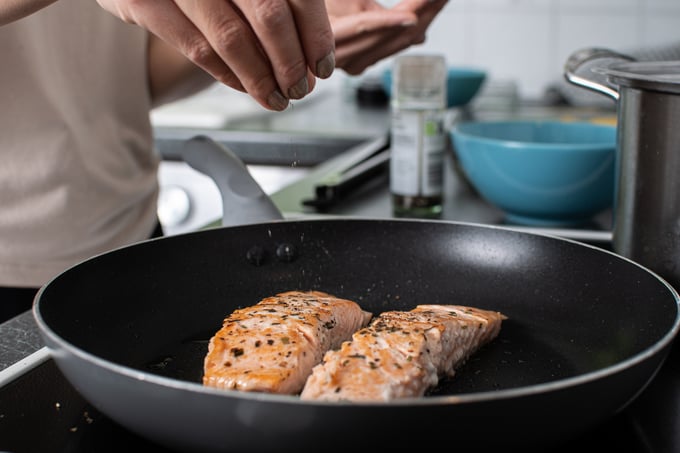
Salmon is fully and safely cooked when it reaches an internal temperature of 145°F. At this temperature, the salmon meat is creamy in color and flakey.
Overcooking salmon meat can lead to dry fish with a tough texture. Use a calibrated food thermometer to check the fish for doneness and determine the internal temperature accurately.
In addition, culinary experts suggest resting the meat after cooking to proper temperatures for at least 3 minutes. This will allow the residual heat to continue the cooking process.
Reaching the correct salmon temperature for cooking is an important approach to food safety and quality. The heat from cooking not only makes the salmon meat safe to consume but also improves its quality.
Specifically, the internal temp range for cooking salmon is important for the following reasons:
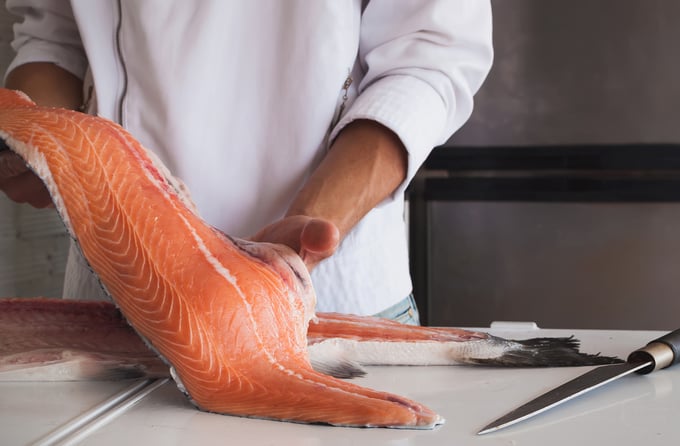
The key to achieving safe and satisfying salmon meat dishes is consistently monitoring proper cooking parameters. To do this, every food business needs a comprehensive food safety system.
At FoodDocs, you can get a smart Food Safety Management System that provides smart solutions. Get features such as automatically-generated monitoring logs and a smart notification system to help you intuitively monitor cooking temperatures.
Read more at the end of this article, or sign up for our free 14-day trial now.
Salmon is a type of fish meat commonly served in different levels of doneness. This type of meat can be cooked to five different levels of doneness:
Provided that your business follows strict food safety practices, you can serve salmon dishes cooked below the target internal temperature.
Now, we discuss the recommended internal temp for each level of doneness and how to determine if your salmon meat is properly cooked.
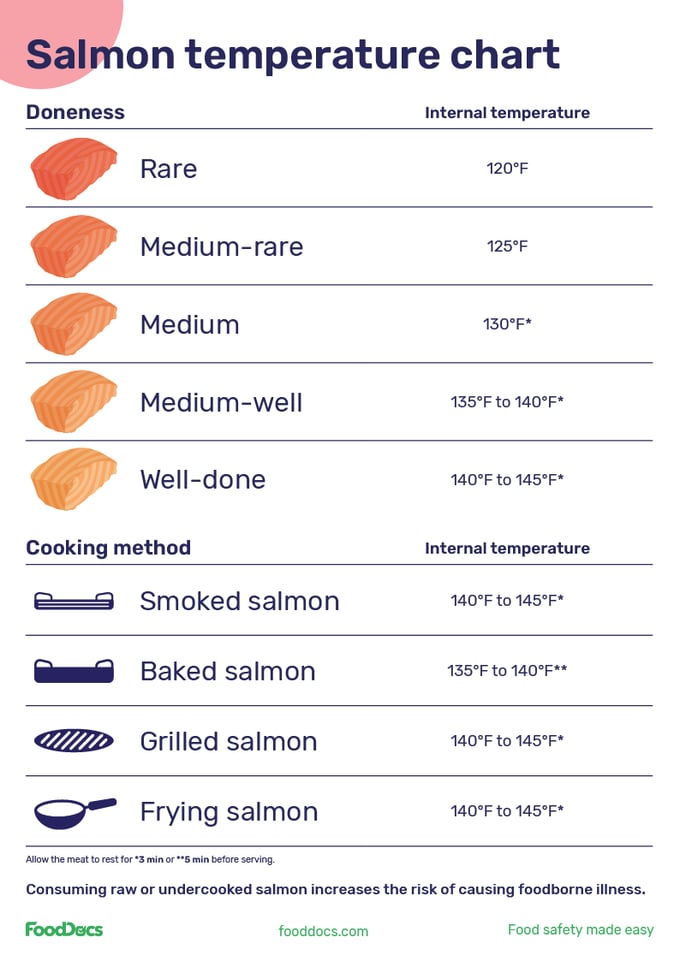
Salmon internal temperature chart
Rare salmon is achieved by cooking the meat to an internal temperature of 120°F. At this level of doneness, the exterior portion of the meat will be seared and fully cooked. As you go deeper into the center of the meat, you will see a slightly translucent and pink flesh.
Rare salmon is known for its moist and buttery characteristics with a delicate texture and pairs well with light sauces. It is important to remember that cooking salmon to rare doneness means that the meat is undercooked.
Consuming raw or undercooked salmon increases the risk of causing foodborne illness to consumers. Customers with weak immune systems may be more at risk of contracting foodborne illness from undercooked salmon meat.
Medium-rare salmon is a popular choice in restaurants and can be achieved by cooking the meat to an internal temperature of 125°F. Salmon cooked to medium-rare doneness will have an opaque and slightly pink center with a fully cooked exterior and skin.
This level of doneness is the perfect combination of undercooked and cooked salmon meat. Medium-rare salmon preserves the natural flavors and juices of salmon while producing new flavors from the cooked exterior.
Medium-rare doneness for salmon is still considered undercooked. As such, your employees must still practice strict food handling and inform the consumers about the risks of consuming undercooked foods.
To achieve a perfectly cooked medium doneness salmon, you must cook the meat to an internal temperature of 130°F with a 3-minute resting time. At a medium level of doneness, salmon meat has a light pink center with a fully cooked exterior.
Medium salmon meat is firm and moist. Medium-cooked salmon retains its natural flavors while providing a slightly firmer bite compared to rare or medium rare.
While medium salmon looks entirely cooked, the recommended internal temperature is still below the safe cooking temp. As such, caution must still be practiced, and customers must be well-informed of the dangers of undercooked salmon meat.
To cook salmon meat to medium-well doneness, the meat must reach an internal temperature of 135°F to 140°F. After reaching the target internal temperature, the meat must be allowed to rest for at least 3 minutes.
Medium-well salmon mean gives a well-cooked impression on the texture of the meat. You can expect firm, flaky, and slightly moist salmon meat. While slightly less moist than medium or medium-rare, medium-well salmon can still be enjoyed with a variety of sauces and seasonings.
Although medium-well salmon is still undercooked, the risk of causing foodborne illness is significantly less. The time dedicated to the meat to rest helps redistribute the heat to kill the majority of pathogens in the meat.
Well-done salmon is cooked to an internal temperature of 140°F to 145° with a 3-minute resting time. At this level of doneness, the salmon meat is ensured to be free of any pathogenic microorganism, such as dangerous bacteria. This means that the meat is safe even for consumers with weak immune systems.
Salmon cooked well done has a creamy white color with no pink center. The meat is cooked through, firm, and flaky. At this level of doneness, the flavors are significantly different from rare doneness and have a more pronounced cooked flavor. The fishy odor is also removed significantly.
It is important to remember that beyond this level of doneness, you will get overcooked, dry, and chewy fish.
Salmon is a versatile fish and can be cooked in many different ways. The proper internal temperature for salmon can vary depending on the cooking method used. Some cooking methods use very high heat to produce particular flavors but can easily lead to overcooked salmon.
Different approaches to cooking salmon will produce different flavors and, potentially, textures. The final internal temperature of the salmon dish is an important parameter to monitor for any cooking method. Using a trusty meat thermometer is best to ensure the proper cooking of salmon.
Below, we discuss the recommended salmon cook temp using different cooking techniques.
There are two ways to smoke salmon, each with its own target internal temperature. If the salmon meat is intended to be fully cooked using the hot smoking technique, the meat must be cooked to an internal temperature of 145°F with a 3-minute resting time. This process requires you to expose the meat to a smoke source at 225°F and can take approximately 3 hours or longer for thicker fillets.
On the other hand, if the smoking technique is only used to prepare the meat, such as in cold smoking, the salmon meat is only recommended to be cooked to an internal temp of 90°F. This method requires other cooking methods, such as baking or grilling, to complete the cooking process and reach the internal temperature of 145°F. Smoking adds a unique flavor to the salmon meat.
Baking salmon uses an oven temperature of around 425°F. This cooking temperature can quickly cook thin salmon fillets. As such, the recommended internal cooking temperature for baking salmon is 135°F to 140°F with at least 5 minutes of resting time on an oven rack.
The mentioned recommended cooking temperature for baked salmon recipes should not be used for frozen cuts of salmon steaks. Salmon meat must be properly thawed to ensure that it will be evenly and thoroughly cooked for maximum safety.
When grilling salmon, the recommended internal temperature is also 145°F with a 3-minute resting time. Preheat the grill to medium-high heat level and grill the salmon until it reaches this internal temperature.
Grilling salmon adds a smokey and charred taste to the meat that is less intense than smoking.
In addition to aiming for a safe internal temperature, grilling salmon is very prone to cross-contamination. To avoid this from happening, make sure to only grill batches of salmon without adding other types of meat on the grill.
Frying a piece of salmon requires an internal cooking temperature of 145°F with a 3-minute resting time. This cooking method is best for serving salmon with a crispy exterior while keeping the fish meat moist and flavorful.
The important thing to remember when preparing a pan-seared salmon is that it needs to be flipped on its side to achieve equal cooking. When monitoring the internal temp of salmon during frying, the food thermometer must be inserted into the thickest part of the meat.
The internal temperature for cooking and salmon doneness play an important part in the product's final quality. Lower internal temperatures, such as those for cooking rare or medium-rare doneness, produce softer and more delicate textures. The meat retains its moisture and has a butter mouthfeel.
As the target internal temperature increases, the meat tends to lose its moisture and becomes more flakey to a point. Beyond well done, the meat becomes tough and very dry.
In terms of flavor, the lower the internal temperature, the more likely it is to retain the natural salmon flavors. Customers often choose rare and medium-rare doneness for the fresh taste of flavorful salmon.
The flavors of salmon meat become different as you cook it to higher temperatures. Bolder flavors are produced as a result of browning on the salmon meat.
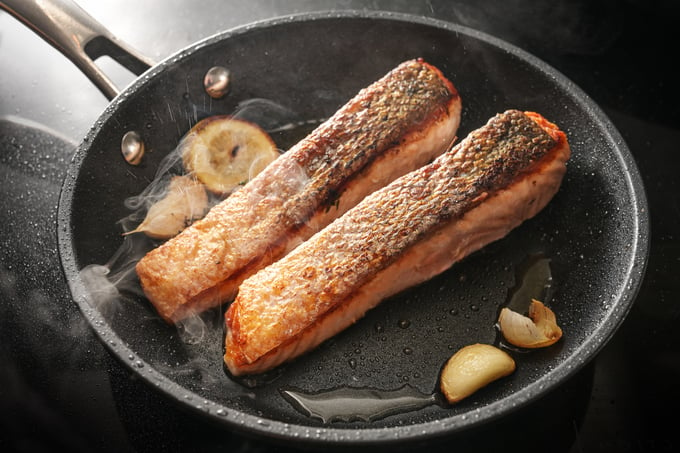 Master sanitation schedule from FoodDocs
Master sanitation schedule from FoodDocs
Achieving a particular flavor and texture in salmon requires close monitoring. A few degrees off of the target temperature can easily change the entire profile of the salmon meat.
Use our Downloadable Cooking Temperature Log to monitor the final internal temperature of your salmon dishes, or create an account in our software.
According to culinary experts, allowing the salmon meat to rest after cooking is an essential step to perfect the target level of doneness.
The resting time for meat is otherwise known as carryover cooking. This refers to the process of removing the meat from the heat source and placing it in a cooling rack.
The resting time for meat is established to help achieve the desired final characteristics without the need to cook the meat at very high temperatures.
The process is also called carryover cooking because the meat continues to cook from the residual or carryover heat. During this time, the temperature and moisture are redistributed to the entire salmon meat. The process will help you achieve an equally cooked and moist final product.
By allowing salmon to rest after cooking, you can achieve a more even internal temperature, improved moisture retention, and enhanced flavors, ultimately resulting in a more enjoyable dining experience.
The ideal and safe storage temperature for fresh and cooked salmon is below 40°F. In particular, salmon is recommended to be kept at a temperature range of 32°F to 38°F to retain its optimum texture and flavor.
When storing fresh raw salmon, you are recommended to keep them in an airtight container as soon as you receive them and remove it from their original packaging.
Fresh salmon meat must only be stored on the shelf used to hold raw meats to avoid cross-contamination. At the recommended temperature, fresh salmon can retain its optimum qualities for a maximum of 2 days.
In the case of cooked salmon meat, the product must be allowed to cool fully after cooking and before it is stored in the refrigerator. Ensure that only the accepted cooling methods are used. Store the cooked salmon in airtight containers, as salmon is considered a major allergen and can contaminate other products. Refrigerated cooked salmon can stay fresh for a maximum of 3 days.
Learn more about how to store your foods from our comprehensive fish storage article.
Download our Free Fridge Organization Chart to guide your employees on how to store salmon and other types of fish properly.
Maintaining food safety when cooking salmon can only be achieved through constant monitoring. This task is essential for ensuring that every salmon dish you serve or distribute is safe for consumption.
Monitoring involves using a thermometer and a record log. At FoodDocs, we take monitoring internal temperature and other food safety tasks very seriously. That is why we developed intuitive solutions to help food businesses like yours in complying with monitoring requirements.
Using our smart Food Safety Management System, you can get customizable smart solutions powered by artificial intelligence and a machine learning program in just 15 minutes.
Here are some of the innovative features and benefits that you can get from our software:

Cooking temperature log with instructions from FoodDocs software
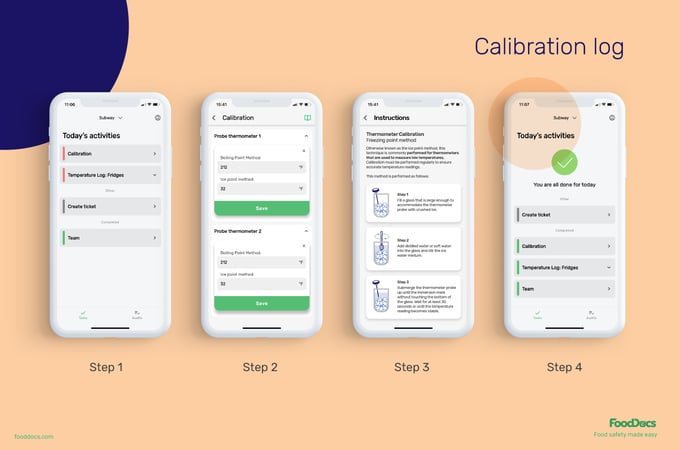
Thermometer calibration log from FoodDocs software
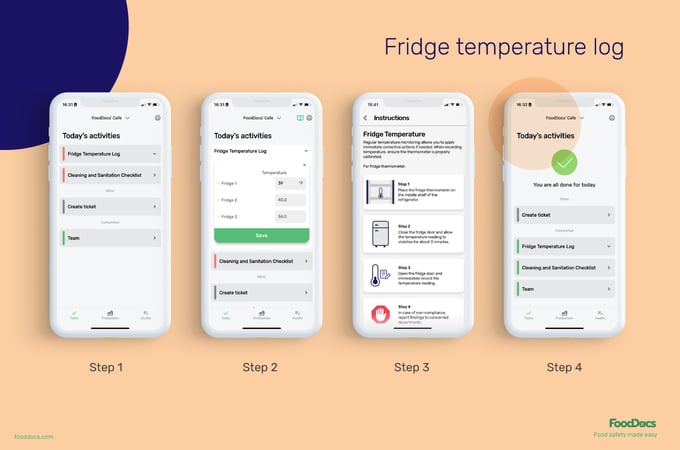
Fridge temperature log from FoodDocs software
You can also create your own monitoring logs and checklists. Each log and checklist can be equipped with instruction materials in addition to the default instructions on the logs.
Our smart software also features a pre-fill solution that you can activate when needed. This smart solution automatically fills logs based on your previously inserted data. It can save you a significant amount of time from manually logging information. All you need to do is verify the information.
Using our mobile app, you can also access a smart notification system that will alert assigned employees for specific tasks, such as monitoring salmon temperature. With this feature, you can ensure that all food safety tasks are done on time.
FoodDocs aims to make food safety compliance easy for all food businesses. As such, our smart software was tailored to help food business owners efficiently verify their compliance tasks with smart features.
With our digital Food Safety Management System, you can easily verify and manage information remotely.
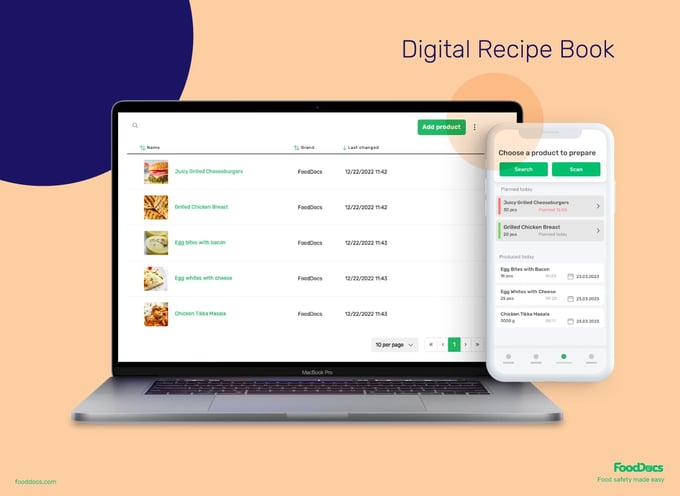
Digital Recipe Book from FoodDocs software
With our smart software, monitoring the internal cooking temperature of salmon and all other food products in your kitchen can be done most efficiently and intuitively. You can ensure that critical tasks are always done on time and correctly without having to manage your team on-site.
Allow our smart software to help your team save time. So, you can focus more on growing your business, while maintaining compliance.
Start your digital food safety compliance journey with FoodDocs. With our smart solutions, you can easily adapt to new trends and improvements as suggested by inspectors. You can quickly apply improvements as all logs and checklists are customizable.
Explore more of our features and services by using our free 14-day trial now.
Do you still have more questions about how to cook salmon and its target internal temperature properly? We gathered some of the most frequently asked questions about this topic and briefly answered them for you.
Yes. Salmon is considered to be cooked and safe for consumption when it reaches an internal temperature of 145°F. The US FDA and USDA recommend this internal temperature.
Salmon can be safely consumed at an internal temperature of 135°F if held at that temperature for at least 15 seconds. At this internal temperature, the salmon meat is cooked to medium-well doneness.
At 160°F, salmon is already overcooked. At this temperature, the salmon meat will already be dry and chewy but is safe to eat.
Salmon does not need to be cooked to 165°F. Cooking salmon to an internal temp of 145°F is enough to keep the dish safe and acceptable to consumers.
Salmon is best grilled when pre-marinated or rubbed with common seasonings, like salt and pepper. Preheat the grill to medium-high heat. Place the salmon skin-side on the grill grate. Grill each side of the salmon fillet until the internal temp reaches 145°F. After grilling, allow the salmon to rest for at least 3 minutes to redistribute the heat and juices.
From a food safety standpoint, both wild and farmed salmon must be cooked to an internal temperature of 145°F for safe consumption. On the other hand, culinary experts recommend cooking farmed salmon at an internal temperature of 125°F and wild salmon at 120°F.
Wild salmon is known to have more connective tissues; the low internal cooking temperature of salmon can help retain more moisture in between these tissues when compared with farmed salmon.
Start your digital food safety journey by using our free 14-day trial.
Learn challenges healthcare foodservice teams face today and key food safety practices to protect vulnerable patients. Get a free healthcare leader...
Learn what Standard Operating Procedures (SOPs) are and how to write effective SOPs that ensure consistency, efficiency, and safety in your...
Boost your retail food safety with essential practices and digital tools to protect customers and your brand. Plus a free Retail Food Safety Leader...